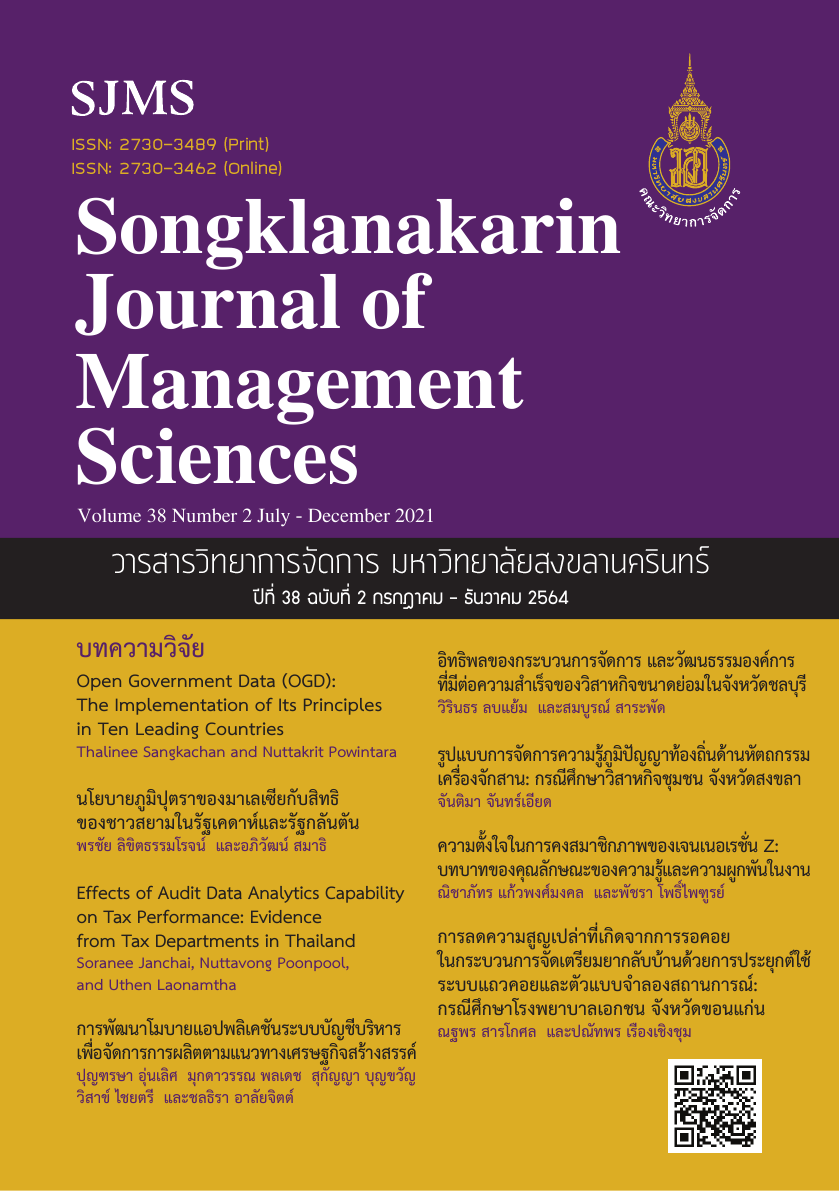รูปแบบการจัดการความรู้ภูมิปัญญาท้องถิ่นด้านหัตถกรรมเครื่องจักสาน: กรณีศึกษาวิสาหกิจชุมชน จังหวัดสงขลา
Main Article Content
บทคัดย่อ
การวิจัยครั้งนี้มีวัตถุประสงค์เพื่อศึกษารูปแบบ กระบวนการ และ ปัจจัยแห่งความสำเร็จของการจัดการความรู้ภูมิปัญญาท้องถิ่นด้านหัตถกรรมเครื่องจักสาน โดยมีวิสาหกิจชุมชน 6 กลุ่ม ผู้ให้ข้อมูลหลัก คือ ผู้อาวุโส/ปราชญ์ชุมชน 1 คน/กลุ่ม ประธานกลุ่มวิสาหกิจชุมชน 1 คน/กลุ่ม และผู้ประกอบอาชีพการจักสาน ไม่น้อยกว่า 5 ปี 7 คน/กลุ่ม รวมทั้งหมด 54 คน ใช้วิธีการสัมภาษณ์เชิงลึก ซึ่งการเลือกผู้ให้ข้อมูลหลักเป็นการเลือกแบบเจาะจง ผลการศึกษาพบว่า รูปแบบการจัดการความรู้ภูมิปัญญาท้องถิ่นด้านหัตถกรรมเครื่องจักสาน ประกอบด้วย 2 ลักษณะ คือ (1) ความรู้ภูมิปัญญาท้องถิ่นดั้งเดิม และ (2) ความรู้ใหม่ที่นำภูมิปัญญาท้องถิ่นมาประยุกต์ สำหรับกระบวนการจัดการความรู้ พบว่า มี 5 ขั้นตอน คือ (1) การกำหนดความรู้จากบรรพบุรุษมากำหนดผลิตภัณฑ์ผ่านการคิดและตัดสินใจร่วมกันของสมาชิกกลุ่ม (2) การแสวงหาและยึดกุมความรู้ เป็นความรู้ได้มาจากทั้งภายในและภายนอกกลุ่มเพื่อให้เกิดความรู้เพิ่มขึ้น (3) การแลกเปลี่ยนความรู้ในกลุ่มเพื่อให้สมาชิกกลุ่มมีทักษะการผลิตมากขึ้น (4) การจัดเก็บความรู้เป็นการจดจำด้วยการฝึกปฏิบัติ และ (5) การถ่ายทอดความรู้จากบุคคลสู่บุคคลโดยการสาธิต ส่วนปัจจัยแห่งความสำเร็จของการจัดการความรู้ พบว่า สมาชิกกลุ่มมีส่วนร่วมเปิดใจยอมรับสิ่งใหม่ ๆ มีความเชื่อมั่นผู้นำกลุ่มรวมไปถึงข้อค้นพบของการวิจัย คือ “การพึ่งตนเอง” ของกลุ่มวิสาหกิจชุมชนซึ่งเกิดจากการเรียนรู้ร่วมกัน นอกจากนั้นประชาชนในชุมชนยังเห็นคุณค่าและหันมาใช้สินค้าที่ผลิตจากสมาชิกกลุ่มของภูมิปัญญาท้องถิ่นหัตถกรรมจักสานมากขึ้น เพื่อสามารถขยายผลนำไปสู่การสร้างการมีส่วนร่วมของการรวมกลุ่มวิสาหกิจชุมชนอย่างยั่งยืน
Article Details

This work is licensed under a Creative Commons Attribution-NonCommercial-NoDerivatives 4.0 International License.
บทความที่ตีพิมพ์ถือเป็นลิขสิทธิ์ของวารสารวิทยาการจัดการ มหาวิทยาลัยสงขลานครินทร์ อย่างไรก็ตาม กองบรรณาธิการไม่สงวนลิขสิทธิ์ในการทำซ้ำ คัดลอก หรือเผยแพร่ แต่จะต้องอ้างอิงให้ถูกต้องตามหลักวิชาการ
References
Arthur, A., Productivity, A., & Center, Q. (1996). The Knowledge Management Assessment Tool: External Benchmarking Version. Retrieved 5 June, 2019, from https://sais.aisnet.org/BartczakEtAl.php.
Dalkir, K. (2005). Knowledge Management in Theory and Practice. Burlington, MA: Elsevier Butterworth-Heinemann.
Duanguppama, S., & Pharnak, P. (2013). Transfer of Local Wisdom on Suea KoK (Reed Mat) Weaving. Journal of Community Development and Life Quality. Faculty of Agriculture Chiangmai University, 1(3), 195-203.
Katusukhavadee, S. (2009). The Local Wisdom Transmission of Folk Handicraft : Case Study of Ban Nong-hiang, Phanut Nikhom District, Chonburi Province. Thesis Master of Arts (Thai Studies). Dhonburi Rajabhat University.
Kongthong, A. (2010). Role model for basketry career development In Phanat-nikhom, Chonburi. Thesis Master of Public Administration Program in Local Government. Khon Kaen University.
Manowang, J., Sapa, w., & Lahuna, T. (2018). Development of Wicker toward the Community Standards in Dong Mada Sub-district, Mae Lao District, Chiang Rai Province. Proceeding of the 13th Naresuan Research Conference, (pp. 926-936).
Manowang, J., & Sepha, W. (2020). Development of the Traditional Handicrafts Wisdom of the Elderly to Enter to the Standard of Wiang Nuea Sub-District, Wiangchai District, Chiang Rai Province. Journal of Community Development Research (Humanities and Social Sciences), 13(1), 128-140.
Marquardt, M. (1996). Building the Learning Organization. New York: McGraw-Hill.
Mertins, K., Heisig, P., & Vorbeck, J. (2003). Knowledge Management: Concepts and Best Practices. 2nd ed. New York: Springer.
National Productivity Institute. (2004). Knowledge Management form theory to practice. Bangkok: Jirawat Express.
Office of the National Culture Commission. (1990). Seminar Report Academic on folk wisdom. Bangkok: ThaiPublica.
Patcharametha, T. (2016). Handicraft products and the development into the OTOP products. Faculty of Fine Arts and Architecture Rajamangala University of Technology Lanna. University journal Fine arts, 36(1), 67-80.
Pootes, U. (2017). Process of Transferring Local Wisdom Wicker in Ban Dongchapu, Bang Maplor Sub-District, Krok Phok Phra District, Nakhon Sawan Province. Journal Social Science, MCU, 6(4), 180-188.
Puongngam, K. (2010). Community and Local Self Government. Bangkok: Borpit-Printing.
Rattanabhoca, J. (2008). Developing of knowledge management model for a handicraft Competency - Based curriculum By Thai Wisdom. Thesis Ph.D. King Mongkut’s King Mongkut’s University of Technology North Bangkok.
Rien Saowapak, S., Akharabawon, J., & Kaewpichit, J. (2005). Knowledge Management. Bangkok: Administrative System Development Group, Office of the Public Sector Development Commission.
Somprajob, P. (2014). Phuen Basketry Handicraft : Knowledge Management Model of Local Wisdom for Local Art and Culture Identity Value by Community Participation. Rajamangala University of Technology Thanyaburi Faculty of Liberal Arts.
Songkhla Community Enterprise. (2020). Community Enterprise Group. Retrieved 18 June, 2020, from https://smce.doae.go.th/ProductCategory/SmceCategory.php
Tabaselo, P. (2017). The Community Sustainable Development: The Correlation between the Sufficiency Economy Community and the Sila 5 village in Ubonratchathani, Sisaket, Buriram and Surin. Journal of MCU Peace Studies, 6(1), 117-128.
Thongruang, P., Lertgrai, P., & Noothongkeaw, K. (2016). The Community Model for. Sustainable learning. Narkbhut Paritat Journal Nakhon Si Thammarat Rajabhat University, 9(2), 192-205.
Varavitpinit, S., Boonkoum, W., & Sungrugsa, N. (2017).The Model Development of Phetchburi city follows philosophy trend of the sufficient economy. Veridian E-Journal Silpakorn University, 10(2), 1657-1674.
Watcharakiettisak, T. (2016). Community economic strengthening by developing community enterprise group at tambonpol songkram administration organization Nonsung District, NakhonRatchasima Province. Journal of Business Administration, 5(1), 43-54.
Wiig, K. (1993). Knowledge Management Foundations. Thinking About Thinking-How Organizations Create, Represent and Use Knowledge. Arlington, TX: Scherma Press.
